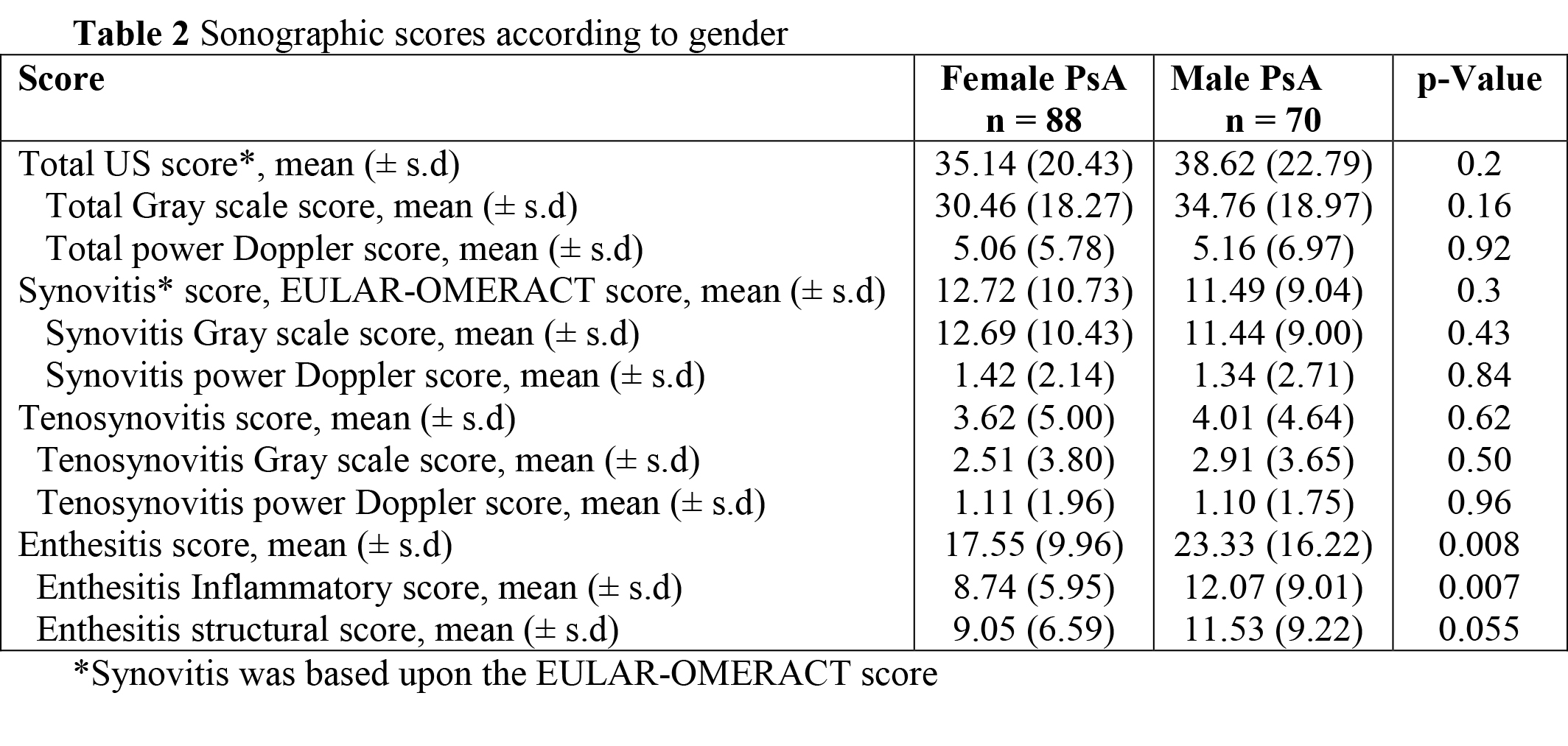Session Information
Session Type: Poster Session D
Session Time: 8:30AM-10:30AM
Background/Purpose: Psoriatic arthritis (PsA) can affect differently women and men. Ultrasound (US) is an important tool in the evaluation of disease activity of PsA. To the best of our knowledge, there is no study that compared sonographic features of PsA between female and male patients.
The aim of this study is to investigate gender-based differences among PsA patients concomitantly evaluated by clinical examination and US.
Methods: The study population included prospectively recruited consecutive adult patients with PsA (CASPAR criteria). Patients’ assessment included physical examination of joints (66/68 tender and swollen joint count, TJC/SJC), enthesitis (LEEDS and SPARCC), dactylitis, skin (PASI) and several patients reported outcome. All the patients underwent a detailed US evaluation (gray scale and Doppler), including 52 joints, 40 tendons and 14 points of entheses (according to MASES index plus lateral epicondyles). The score of the US was based on the summation of a semi-quantitative score (0-3) for synovitis (EULAR-OMERACT definition), tenosynovitis, and enthesitis score. The US enthesitis score was categorized to inflammatory (hypoechogenicity, thickening, bursitis and Doppler) and to structural score (erosions and enthesophytes). All the evaluations occurred on the same day, and the sonographer was blinded to the clinical data. Patients were asked to stop NSAIDS 3 days before the evaluation.
The association between gender and US scores was assessed by multivariate ordinal logistic regression models adjusted for potential confounders (age, BMI, PsA duration, CRP, csDMARDS, and biologics).
Results: The study population included 159 PsA patients, 70 males and 89 females (table 1). The rate of employment was significantly higher in males compared to females (p=0.007). PASI and SJC were significantly higher in males compared to females (p=0.04). Disease duration, other indices of PsA activity, and treatment profile were similar in both genders.
The total US score and its subcategories, synovitis and tenosynovitis scores, were similar between the genders, whereas the total enthesitis score and its subcategory, inflammatory enthesitis score, were significantly higher in males vs females (23.33 ± 16.22 vs 17.55 ± 9.96 and 12.07±9.01 vs 8.74± 5.95, p=0.007, respectively) (table 2). In addition, male had significantly more prevalent hypoechogenicity, thickening, bursitis and enthesophytes compared to females (p< 0.001). Furthermore, there was a gender-based significant difference of US enthesitis total scores by anatomical sites: triceps to olecranon, quadriceps to patella, patellar tendon insertion to distal patella and to tibial tuberosity and Achilles tendon insertion which had a significantly higher US enthesitis score in males compared to females (table 3).
Finally, multivariate ordinal logistic regression models showed that male were prone to higher US inflammatory enthesitis score (OR 1.88, p=0.04).
Conclusion: The main gender-based sonographic difference in PsA patients was higher enthesitis score in males, in particular, higher inflammatory US enthesitis score, whereas these differences were not reflected by the standardized clinical enthesitis and disease activity scores.
 Table 1 Demographics and clinical characteristics according to gender
Table 1 Demographics and clinical characteristics according to gender
 Table 2 Sonographic scores according to gender
Table 2 Sonographic scores according to gender
 Table 3: Comparison of US enthesitis feature by enthesitis site between female and male
Table 3: Comparison of US enthesitis feature by enthesitis site between female and male
To cite this abstract in AMA style:
Furer V, Wollman J, levartovsky D, Aloush V, Borok Lev-Ran S, Paran D, Elkayam O, Polachek A. Gender Based Differences in Clinical and Sonographic Assessment Among Patients with Psoriatic Arthritis [abstract]. Arthritis Rheumatol. 2021; 73 (suppl 9). https://acrabstracts.org/abstract/gender-based-differences-in-clinical-and-sonographic-assessment-among-patients-with-psoriatic-arthritis/. Accessed .« Back to ACR Convergence 2021
ACR Meeting Abstracts - https://acrabstracts.org/abstract/gender-based-differences-in-clinical-and-sonographic-assessment-among-patients-with-psoriatic-arthritis/
